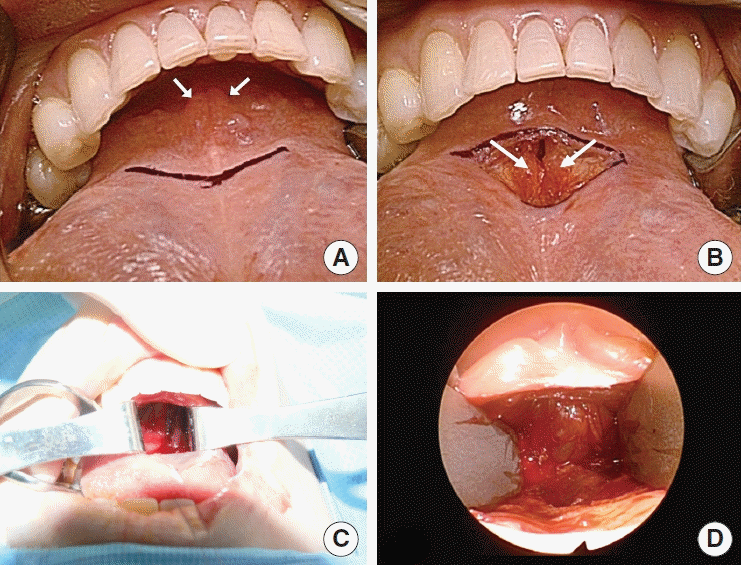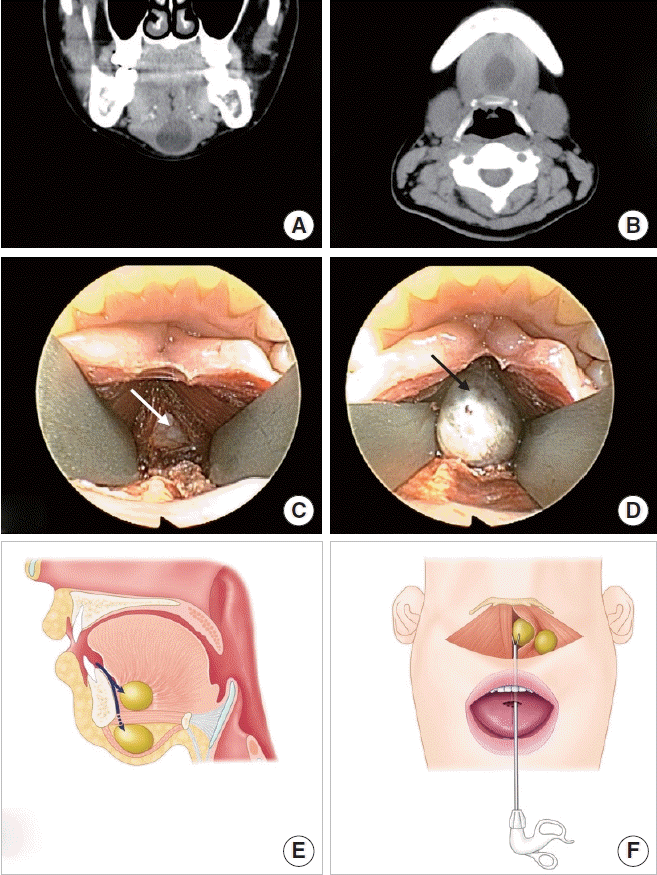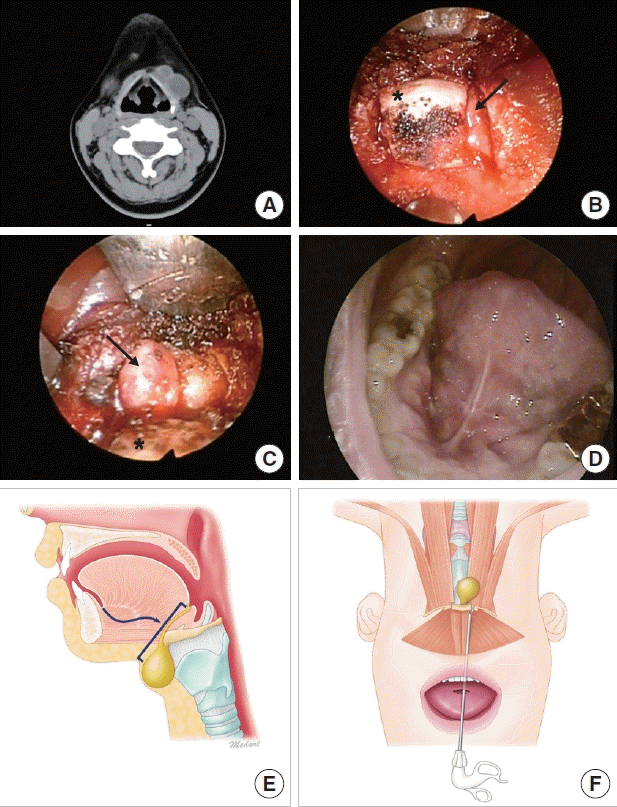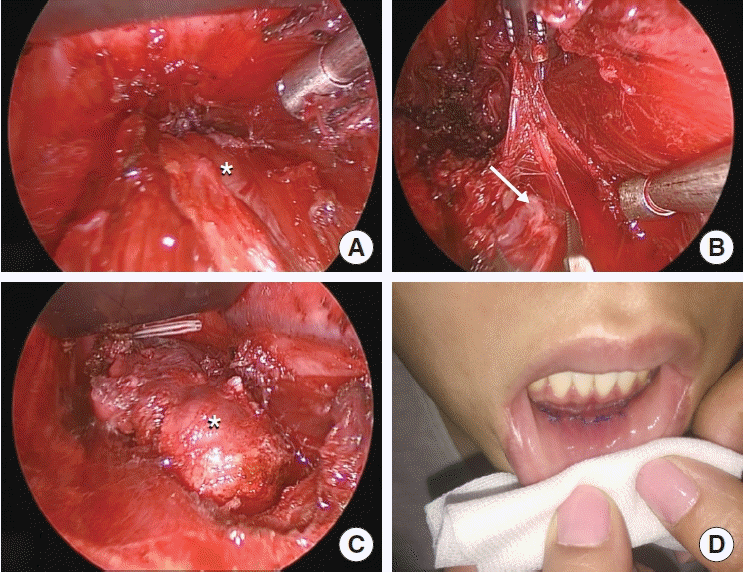1. Park JO. Facelift approach for resecting benign upper neck masses. World J Surg. 2017; Jun. 41(6):1488–93.

2. Rumsey N, Clarke A, White P. Exploring the psychosocial concerns of outpatients with disfiguring conditions. J Wound Care. 2003; Jul. 12(7):247–52.

3. Gagner M, Inabnet WB 3rd. Endoscopic thyroidectomy for solitary thyroid nodules. Thyroid. 2001; Feb. 11(2):161–3.

4. Lee HS, Lee D, Koo YC, Shin HA, Koh YW, Choi EC. Endoscopic resection of upper neck masses via retroauricular approach is feasible with excellent cosmetic outcomes. J Oral Maxillofac Surg. 2013; Mar. 71(3):520–7.

5. Kim JP, Lee DK, Moon JH, Park JJ, Woo SH. Transoral dermoid cyst excision: a multicenter prospective observational study. Otolaryngol Head Neck Surg. 2018; Dec. 159(6):981–6.

6. Kim JP, Park JJ, Jeon SY, Ahn SK, Hur DG, Kim DW, et al. Endoscopeassisted intraoral resection of external dermoid cyst. Head Neck. 2012; Jun. 34(6):907–10.

7. Kim JP, Park JJ, Lee EJ, Woo SH. Intraoral removal of a thyroglossal duct cyst using a frenotomy incision. Thyroid. 2011; Dec. 21(12):1381–4.

8. Kim JP, Park JJ, Park HW, Woo SH. Endoscopy-assisted resection of a submandibular gland mass via a thyroidectomy incision. Ear Nose Throat J. 2015; Sep. 94(9):E30–3.
9. Kim JP, Park JJ, Woo SH. No-scar transoral thyroglossal duct cyst excision in children. Thyroid. 2018; Jun. 28(6):755–61.

10. Woo SH. Endoscopic-assisted total thyroidectomy via lateral keloid scar incision. Clin Exp Otorhinolaryngol. 2014; Dec. 7(4):338–41.

11. Woo SH. Endoscope-assisted transoral thyroidectomy using a frenotomy incision. J Laparoendosc Adv Surg Tech A. 2014; May. 24(5):345–9.

12. Woo SH. Endoscope-assisted transoral accessory parotid mass excision. Head Neck. 2016; Jan. 38(1):E7–12.

13. Woo SH, Jeong HS, Kim JP, Park JJ, Baek CH. Endoscope-assisted intraoral removal of ectopic thyroid tissue using a frenotomy incision. Thyroid. 2013; May. 23(5):605–8.

14. Woo SH, Jeong HS, Kim JP, Park JJ, Baek CH. Endoscope-assisted frenotomy approach to median upper neck masses: clinical outcomes and safety (from a phase II clinical trial). Head Neck. 2014; Jul. 36(7):985–91.

15. Woo SH, Kim JP, Baek CH. Endoscope-assisted extracapsular dissection of benign parotid tumors using hairline incision. Head Neck. 2016; Mar. 38(3):375–9.

16. Clark MP, Qayed ES, Kooby DA, Maithel SK, Willingham FF. Natural orifice translumenal endoscopic surgery in humans: a review. Minim Invasive Surg. 2012; 2012:189296.

17. Anuwong A. Transoral endoscopic thyroidectomy vestibular approach: a series of the first 60 human cases. World J Surg. 2016; Mar. 40(3):491–7.

18. Anuwong A, Ketwong K, Jitpratoom P, Sasanakietkul T, Duh QY. Safety and outcomes of the transoral endoscopic thyroidectomy vestibular approach. JAMA Surg. 2018; Jan. 153(1):21–7.

19. Kim HY, Chai YJ, Dionigi G, Anuwong A, Richmon JD. Transoral robotic thyroidectomy: lessons learned from an initial consecutive series of 24 patients. Surg Endosc. 2018; Feb. 32(2):688–94.

20. Turetschek K, Hospodka H, Steiner E. Case report: epidermoid cyst of the floor of the mouth: diagnostic imaging by sonography, computed tomography and magnetic resonance imaging. Br J Radiol. 1995; Feb. 68(806):205–7.
21. Zachariades N, Skoura-Kafoussia C. A life-threatening epidermoid cyst of the floor of the mouth: report of a case. J Oral Maxillofac Surg. 1990; Apr. 48(4):400–3.

22. Calderon S, Kaplan I. Concomitant sublingual and submental epidermoid cysts: a case report. J Oral Maxillofac Surg. 1993; Jul. 51(7):790–2.

23. Longo F, Maremonti P, Mangone GM, De Maria G, Califano L. Midline (dermoid) cysts of the floor of the mouth: report of 16 cases and review of surgical techniques. Plast Reconstr Surg. 2003; Nov. 112(6):1560–5.

24. Ariyoshi Y, Shimahara M. Magnetic resonance imaging of a submental dermoid cyst: report of a case. J Oral Maxillofac Surg. 2003; Apr. 61(4):507–10.

25. Bodner L, Woldenberg Y, Sion-Vardy N. Dermoid cyst of the maxilla. Int J Oral Maxillofac Surg. 2005; Jun. 34(4):453–5.

26. Woo SH, Park JJ, Kwon M, Kim JP. “Hidden scar” submandibular gland excision using an endoscope-assisted hairline approach. Oral Oncol. 2017; Feb. 65:83–8.

27. Kim HS, Chung SM, Pae SY, Park HS. Endoscope assisted submandibular sialadenectomy: the face-lift approach. Eur Arch Otorhinolaryngol. 2011; Apr. 268(4):619–22.

28. Akao I, Nobukiyo S, Kobayashi T, Kikuchi H, Koizuka I. A case of large dermoid cyst in the floor of the mouth. Auris Nasus Larynx. 2003; Feb. 30 Suppl:S137–9.

29. Leveque H, Saraceno CA, Tang CK, Blanchard CL. Dermoid cysts of the floor of the mouth and lateral neck. Laryngoscope. 1979; Feb. 89(2 Pt 1):296–305.

30. Radkowski D, Arnold J, Healy GB, McGill T, Treves ST, Paltiel H, et al. Thyroglossal duct remnants: preoperative evaluation and management. Arch Otolaryngol Head Neck Surg. 1991; Dec. 117(12):1378–81.

31. Allard RH. The thyroglossal cyst. Head Neck Surg. 1982; Nov-Dec. 5(2):134–46.

32. Sammarco GJ, Mc Kenna J. Thyroglossal duct cysts in the elderly. Geriatrics. 1970; Aug. 25(8):98–101.
33. Hussain K, Henney S, Tzifa K. A ten-year experience of thyroglossal duct cyst surgery in children. Eur Arch Otorhinolaryngol. 2013; Nov. 270(11):2959–61.

34. Marianowski R, Ait Amer JL, Morisseau-Durand MP, Manach Y, Rassi S. Risk factors for thyroglossal duct remnants after Sistrunk procedure in a pediatric population. Int J Pediatr Otorhinolaryngol. 2003; Jan. 67(1):19–23.

35. Woo SH, Park JJ, Hong JC, Wang SG, Park GC, Eun YG, et al. Endoscope-assisted transoral removal of a thyroglossal duct cyst using a frenotomy incision: a prospective clinical trial. Laryngoscope. 2015; Dec. 125(12):2730–5.

36. Lin ST, Tseng FY, Hsu CJ, Yeh TH, Chen YS. Thyroglossal duct cyst: a comparison between children and adults. Am J Otolaryngol. 2008; Mar-Apr. 29(2):83–7.

37. Maddalozzo J, Venkatesan TK, Gupta P. Complications associated with the Sistrunk procedure. Laryngoscope. 2001; Jan. 111(1):119–23.

38. Mondin V, Ferlito A, Muzzi E, Silver CE, Fagan JJ, Devaney KO, et al. Thyroglossal duct cyst: personal experience and literature review. Auris Nasus Larynx. 2008; Mar. 35(1):11–25.

39. Perkins JA, Inglis AF, Sie KC, Manning SC. Recurrent thyroglossal duct cysts: a 23-year experience and a new method for management. Ann Otol Rhinol Laryngol. 2006; Nov. 115(11):850–6.

40. Shah R, Gow K, Sobol SE. Outcome of thyroglossal duct cyst excision is independent of presenting age or symptomatology. Int J Pediatr Otorhinolaryngol. 2007; Nov. 71(11):1731–5.

41. Brousseau VJ, Solares CA, Xu M, Krakovitz P, Koltai PJ. Thyroglossal duct cysts: presentation and management in children versus adults. Int J Pediatr Otorhinolaryngol. 2003; Dec. 67(12):1285–90.

42. Lee JS, Kim JP, Ryu JS, Woo SH. Effect of wound massage on neck discomfort and voice changes after thyroidectomy. Surgery. 2018; Nov. 164(5):965–71.

43. Huscher CS, Chiodini S, Napolitano C, Recher A. Endoscopic right thyroid lobectomy. Surg Endosc. 1997; Aug. 11(8):877.

44. Henry JF, Sebag F. Lateral endoscopic approach for thyroid and parathyroid surgery. Ann Chir. 2006; Jan. 131(1):51–6.
45. Yang HM, Shin KJ, Min J, Woo SH. Anatomical study of gasless transoral thyroidectomy and clinical application. Surg Endosc. 2020; Aug. 34(8):3414–23.

46. Woo SH. Endoscope-assisted intraoral removal of the thyroid isthmus mass using a frenotomy incision. J Laparoendosc Adv Surg Tech A. 2013; Sep. 23(9):787–90.

47. Tae K. Complications of transoral thyroidectomy: overview and update. Clin Exp Otorhinolaryngol. 2021; May. 14(2):169–78.

48. Hong YT, Woo SH. Robotic modified radical neck dissection through the bilateral axillary breast approach. Clin Exp Otorhinolaryngol. 2021; Feb. 14(1):13–4.

49. Kim SI, Min HK, Kang DW, Choi SY, Kang HJ, Lee YC, et al. Modified transoral endoscopic thyroidectomy technique using trapdoor suspension sutures. Clin Exp Otorhinolaryngol. 2021 Mar 30 [Epub].
https://doi.org/10.21053/ceo.2021.00101.

50. Tae K. Transoral thyroidectomy: is it a real game changer. Clin Exp Otorhinolaryngol. 2020; May. 13(2):93–4.

51. Tae K, Ji YB, Song CM, Ryu J. Robotic and endoscopic thyroid surgery: evolution and advances. Clin Exp Otorhinolaryngol. 2019; Feb. 12(1):1–11.

52. Padalhin AR. Lasers and robots: recent developments in transoral laser and transoral robotic surgery. Med Lasers. 2020; Dec. 9(2):103–9.

53. Lee SJ, Chung PS, Chung SY, Woo SH. Transoral laser excision of a pyriform sinus cyst. Med Lasers. 2019; Dec. 8(2):84–6.

54. Hong JC, Lee KD. Transoral laser surgery for supraglottic carcinoma. Med Lasers. 2013; Jun. 2(1):1–7.





 PDF
PDF Citation
Citation Print
Print








 XML Download
XML Download